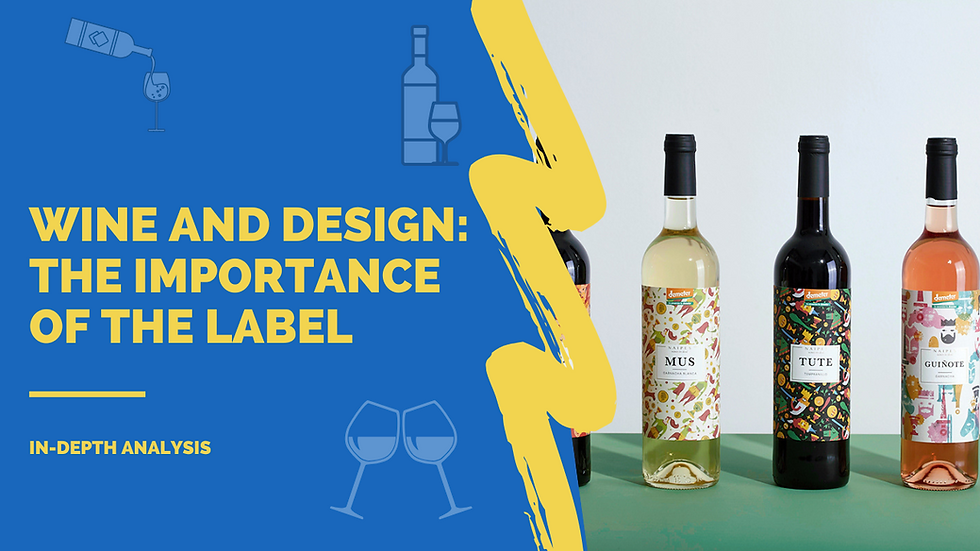Wine and Design: The Importance of the Label
- Alkam

- Mar 27
- 6 min read
Updated: Aug 28

Index
Why design is crucial in wine labels
European regulations on wine labeling
Completed projects: some examples
Label and design
Materials and sustainability in wine packaging
Trends and innovations: from digital labels to augmented reality
FAQ
Conclusions
Why design is crucial in wine labels
Have you ever tried to think about what is the first thing you notice on a bottle of wine?
Yes, perhaps the answer is obvious, but it is not always given the importance it deserves: the label. Deciding which bottle of wine to choose can often be challenging for those who are not experts.
In supermarkets and specialty stores, we find countless bottles of wine on the shelves, so the product needs to capture our attention, arouse our curiosity, and be easy to remember.
In fact, most of us may not be very knowledgeable about this subject, and when choosing a bottle of wine, we will mainly base our decision on the label. It is undeniable that consumers buy with their eyes first, especially if they have to choose a bottle from a store shelf without the help of a sommelier.
According to a study by wine.it conducted on a sample of 2,000 wine drinkers, 82% say that their decision is based mainly on the label.
European regulations on wine labeling
However, aside from the design aspect, it should also be noted that Italy has regulations governing wine labeling. In Europe, this is governed by Regulation (EU) No. 1308/2013, which replaced the previous EEC Regulation No. 1493/1999, and by subsequent updates that came into force in December 2023.
Today, in addition to the traditional elements, wine labels must also include information on ingredients and nutritional declarations (energy, sugars, fats, etc.), which can be provided in digital format via QR codes.
In particular, the mandatory information is:
Designation of origin or geographical indication (if applicable)
Wine classification
Name or business name of the bottler
Bottler's address
Nominal volume
Actual alcohol content
Batch
Year (where applicable)
Ingredients and nutritional declaration (directly on the label or via QR code)
We have written an in-depth article on wine labeling regulations: click here to read it.
Case studies: designer wine labels we have created
To understand how design and choice of materials can transform the perception of a bottle, here are two projects that illustrate Alkam's tailor-made approach to printing labels for designer wine bottles.
Cannonau Riserva “Su Mère” – Un Mare di Vino
For this intense Sardinian wine, packaging was chosen that would convey the deep black color of Cannonau even before tasting it. Fedrigoni Arconvert's Tintoretto Black Pepper paper made it possible to achieve a total black look without white borders, enriched with hot gold printing and relief screen printing. The result is a label that conveys elegance and evokes the waves of the Sardinian sea.
Click here to read the case study
Antichi Granai – brand identity restyling
Fedrigoni Artconvert's Tintoretto Crystal Salt paper was used for the “Antichi Granai” wines, as part of a wider brand renewal project. The relief screen printing finish and “crystal” effect have given it a modern look and tactile experience, reinforcing the premium perception of the product. Thanks to their water resistance, these labels maintain their aesthetics and functionality even in critical conditions, such as in an ice bucket.
These cases demonstrate how careful selection of paper, finishes, and printing techniques can transform a label into a true communication and positioning tool for wines.
Click here to read the case study
Wine label design
Label design therefore becomes a fundamental and strategic element in guiding consumer choice. For example, a label can influence the perceived quality of a wine, making it appear more expensive or better than it is, or trigger the opposite effect, causing enormous damage to the image and sales of various companies.
In such a saturated market, given the new trends that are taking hold, it is necessary to stand out from the competition, not only to capture the consumer's attention, but also to tell a story and stimulate curiosity.
At this point, the main question is: what should a label look like in order to influence the consumer?
With very little space available and certain information that must be included, each graphic element must be chosen very carefully to ensure maximum visual and emotional impact. Today's designs are bold, challenging traditional rules and metrics, even though many historic wineries value tradition, continuing to guarantee a vintage look that conveys the quality of the product through classic images and calligraphy.
On the contrary, younger wineries have a modern and design-oriented approach, because, as these are wines with limited visibility, it can be truly unexpected and impactful, making it an excellent way to promote a new wine.
Colours
Wine bottle colors generally involve pretty standard colors, so:
Red wines are often paired with deep, dark colors on light labels or rich, inky red, blue and gold colors on dark labels.
White wines vary in color from blue, green and yellow on light labels. For bubbles, gold or silver are used combined with soft colors such as pink.
Again, thanks to the use of colors, it is also possible to diversify a company's product range and therefore identify the production lines differently.

Images
The images give a truly unique design. It can summarize the distinctive signs of the company and the territory but at the same time you can totally divert the choice on a subject that captures attention becoming the protagonist .
Wines become true works of art , today, minimalism has aroused the interest of many producers. The message on the bottle is linear and clean, thanks also to elementary shapes and simple characters.
On the contrary, some brands prefer an abstract structure almost like contemporary art that stimulates a limited and exclusive perception of the brand , even using only and exclusively images.
Many producers also decide to rely on designer labels, commissioning the creation of the label to real artists who reflect the uniqueness of their product.
The Font
The use of typography in label design is a rapidly growing choice today, with some brands preferring labels that feature only custom fonts , such as handwritten or oversized fonts.
In relation to the classic trend, many brands prefer hot stamping with gold or silver foil and embossing that give an even more elegant look; touch is also a fundamental element: the materials chosen must be performing to adapt to different situations especially destinations.
Many wineries therefore choose to use embossed printing effects, offering the consumer a very pleasant tactile experience.

Some types of materials
The specific materials for labelling wine bottles represent a fundamental choice, an effective design will not have the desired effect if printed on an unsuitable material .
Over the years, Alkam has collaborated with several wineries, creating high-quality labels to dress wine bottles. In recent years, this sector has shifted towards a sustainable footprint .
For this reason we have decided to introduce several green materials , with a clear and precise message: respect and attention for the environment and for the future.
Research is the first important step, depending on the peculiarities of a product, retracing all the steps we have presented above.
From the moment of its production to the table, a bottle of wine and therefore its label passes through many hands and situations: they are cooled, wetted, heated.
When choosing the material and the printing method, take these small aspects into consideration.
Trends and innovations: from digital labels to augmented reality
The future of wine label design lies in technology:
QR codes to access nutritional information, traceability and storytelling;
augmented reality labels, which transform the bottle into an interactive experience;
multisensory design, which combines sight and touch with innovative reliefs and textures.
FAQ
What information must be included on wine labels?
The name and address of the bottler, the designation, volume, alcohol content, batch number and year of production (where applicable).
Can label design influence sales?
Yes, over 80% of consumers say they choose wine based on the label.
Can I use QR codes on wine labels?
Yes, and this practice is also encouraged by EU legislation: it allows you to communicate ingredients, nutritional values and marketing information.
What sustainable materials are used for wine labels?
Recycled paper, natural fibres (cotton, hemp) and FSC-certified substrates are among the most common.
What has changed since December 2023? Wine labels must also include nutritional information and a list of ingredients. This information can be provided directly on the label or via a QR code, thus offering transparency to consumers and simplification for producers.
Conclusions
Wine labels are a key element in every winery's marketing strategy: they not only provide information, but also communicate the brand's identity, quality and values. Effective design stems from a balance between regulations, creativity and technological innovation.
In an increasingly competitive market, wineries that invest in high-quality labels – sustainable, digital and visually striking – are able to stand out and strengthen their relationship with consumers.
















Comments